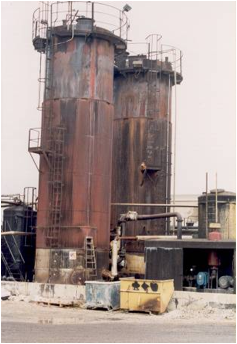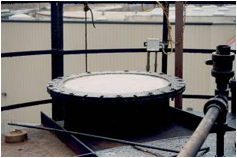Oxidizer Tank Steam Explosion
 Figure 1. Oxidizer tanks used in the production of asphalt for roofing shingles. Figure 1. Oxidizer tanks used in the production of asphalt for roofing shingles. Figure 2. Rupture disk located on top of the oxidizer tanks to prevent accidental tank bursting. Figure 2. Rupture disk located on top of the oxidizer tanks to prevent accidental tank bursting. |
When we think of explosions, ordinary water is not often found on the list of dangerous chemicals. When water rapidly changes to steam however, pressure can build to levels high enough to cause significant structural damage and injury. Figure 1 shows two large tanks (oxidizer tanks) used in the process of manufacturing asphalt for use in the production of roofing shingles. The tanks are 42 feet tall by 12 feet in diameter. During normal use they each hold about 22 thousand gallons of a tar-like material held at a temperature of 475 degrees Fahrenheit. Air is blown through the material and other chemicals added in preparation of the final asphalt product.
A significant quantity of water was accidentally injected into one of the two tanks resulting in a steam explosion. The tanks were designed to safely vent in the event of such an explosion. Figure 2 shows one of the safety vents capped with a thin piece of sheet metal called a rupture disk. In the event of an explosion, this disk is designed to burst at a pressure significantly lower than the burst pressure of the tank itself. Once the disk ruptures, the vents are sized large enough to allow the explosive gases to escape fast enough to limit the pressure rise in the tank. In this case the tank vented the explosive gases as designed, but some of the hot asphalt material inside the tank also escaped landing on an employee below causing severe burns.
The injured employee sued, arguing that the tank was defective because it lacked an adequate means of relieving pressure which was likely to build up during use of the tank, and because it lacked means of deflecting the contents of the tank away from people in the event the tank became over-pressurized during use. An inspection and analysis of the process piping revealed that the accidental injection of water was due to modifications made to the tank’s piping system long after its original design and installation. The judge in the case ruled in favor of the original system designer holding that, “the chemical engineering expert working for the injured employee was not competent to testify that the lack of a deflector device around the rupture disk openings on the tank constituted a design defect because he had neither designed or seen designs for such a device and was unaware of any custom or practice in the industry or any industry or government standard requiring the installation of such a device.” This judgment was upheld on appeal.
